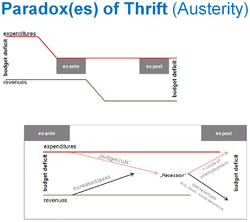Austerity
Austerity measures (political-economics) are government actions that try to reduce government budget deficits. They do this by spending less, increasing tax, both, or some other clever ways.[1][2][3]
Austerity measures are used by governments that find it difficult to pay their debts. The measures are meant to reduce the budget deficit by bringing government revenue closer to spending.
In most macroeconomic models, austerity policies generally increase unemployment as government spending falls.[4][5] Decreased government spending reduces public and maybe private employment. Also, tax increases can reduce consumption by cutting household disposable income. Some say that reducing spending may result in a higher debt-to-GDP ratio because government expenditure itself is a part of GDP.
For example, after the Great Recession, austerity measures in many European countries were followed by increasing unemployment and debt-to-GDP ratios despite smaller budget deficits.[6] When an economy is operating at or near capacity, higher short-term deficit spending (stimulus) can cause interest rates to rise. This results in a reduction in private investment. This then reduces economic growth. Where there is excess capacity, the stimulus can result in an increase in employment and output.[7][8]
Austerity Media
Sectoral balances in US economy 1990–2012. By definition, the three balances must net to zero. Since 2009, the US capital surplus and private-sector surplus have driven a government budget deficit.
Relationship between fiscal tightening (austerity) in eurozone countries with their GDP growth rate, 2008–12
David Cameron, Prime Minister of the United Kingdom, 2010–2016
Related pages
- Functional finance
- Neoliberalism
- Planned shrinkage
- Trickle-down economics
References
- ↑ "Austerity measure". Financial Times Lexicon. Archived from the original on 22 March 2013. Retrieved 1 March 2013.
- ↑ Traynor, Ian; Katie Allen (11 June 2010). Austerity Europe: who faces the cuts. London: Guardian News. http://www.guardian.co.uk/business/2010/jun/11/europe-deficit-crisis-austerity-budgets. Retrieved 29 September 2010.
- ↑ Wesbury, Brian S.; Robert Stein (26 July 2010). "Government Austerity: The Good, Bad And Ugly". Forbes. https://www.forbes.com/2010/07/26/government-spending-taxes-opinions-columnists-brian-wesbury-robert-stein.html. Retrieved 29 September 2010.
- ↑ "Austerity – Pros and Cons". Economics Help.
- ↑ What is austerity?. The Economist. https://www.economist.com/buttonwoods-notebook/2015/05/20/what-is-austerity.
- ↑ House, Christopher; Proebsting, Christian; Tesar, Linda (2017-04-11). "Austerity in the aftermath of the Great Recession". VoxEU.org. Retrieved 2019-07-18.
- ↑ Krugman, Paul (15 April 2012). "Europe's Economic Suicide". The New York Times. https://www.nytimes.com/2012/04/16/opinion/krugman-europes-economic-suicide.html.
- ↑ Laura D'Andrea Tyson (1 June 2012). Confusion about the Deficit. New York Times. http://economix.blogs.nytimes.com/2012/06/01/confusion-about-the-deficit/. Retrieved 16 May 2013.
Other websites
- The Austerity Zone: Life in the New Europe – videos by The New York Times
- Socialist Studies Special Edition on Austerity (2011)
- Panic-driven austerity in the Eurozone and its implications Paul De Grauwe, Yuemei Ji, 21 February 2013 Archived 23 April 2021 at the Wayback Machine
- NYT Review of Books – Paul Krugman – How the Case for Austerity Has Crumbled – June 2013
- IMF Working Paper-Olivier Blanchard and Daniel Leigh-Growth Forecast Errors and Fiscal Multipliers-January 2013
- How Austerity Kills. The New York Times. 12 May 2013.
- The Austerity Delusion; Why a Bad Idea Won Over the West May/June 2013 Foreign Affairs
- Video: Richard Koo debates Kenneth Rogoff about the need for austerity, Institute for New Economic Thinking inaugural conference, 22 April 2010
- "Debt may be 'Schuld' in German, but it's 'belief' in Italian and 'faith' in English" Interview with Mark Blyth Science Portal L.I.S.A., 26 January 2015
- Austerity’s Greek Death Toll: Study Connects Strict Measures to Rise in Suicides. Truthdig. 4 February 2015.
- Hundreds of mental health experts issue rallying call against austerity. The Guardian. 17 April 2015.
- Juice Rap News (April 2015). The EuroDivision Contest, a satire/parody of austerity
- Is austerity the new normal? A look at Greece and France, Tony Cross
- Life Under Austerity. Jacobin. 12 July 2015.
- Austerity policies do more harm than good, IMF study concludes. The Guardian. 27 May 2016.
- When left-leaning parties support austerity, their voters start to embrace the far right. The Washington Post. November 20, 2018






